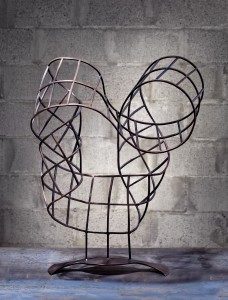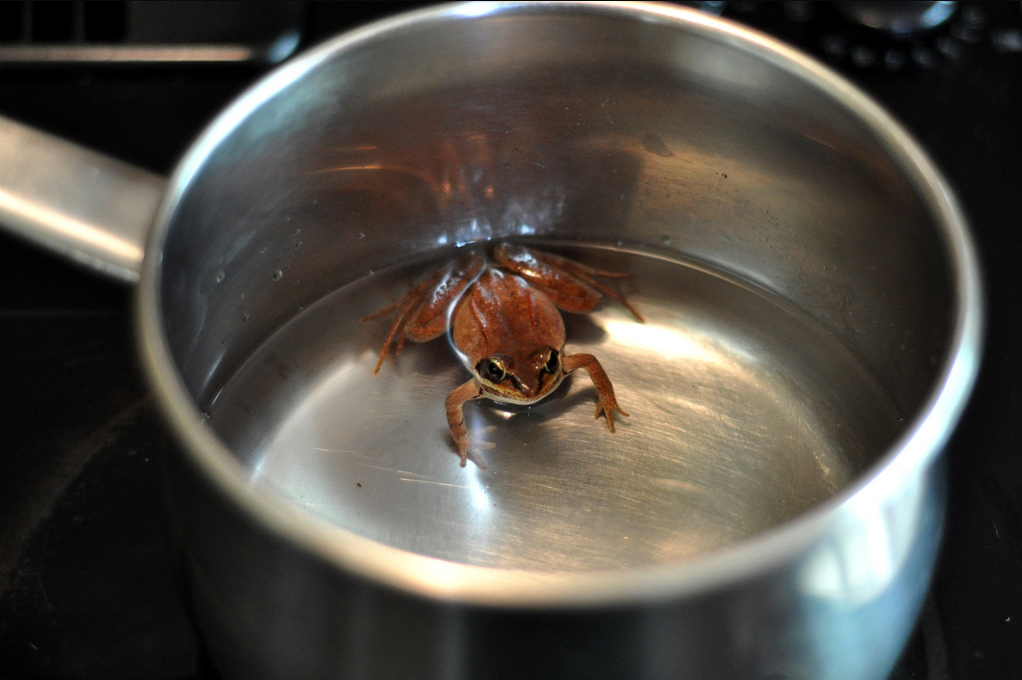When you work on something for a while, it’s easy to forget how far you’ve come. You know: it’s that old frog in the pot metaphor, except the outcome is sometimes – as in this case – positive.
Change happens, even if it seems like it didn’t.
I’m getting a good reminder of that right now as I recreate a project I did about 10 months ago that apparently didn’t end as well as I’d hoped ….
Right now I’m in day 3 of 3D printing a pedestal for a sculpture I sold last year at the big Hidden In The Hills studio tour, The patrons who purchased the sculpture have a big glass entryway in their home that opens onto a domed area. Beneath the dome is a stainless steel inset ring in the floor that complements the dome above.
They were looking for a light, airy sculpture to place there, and found it in my piece Rush (above, right). But they needed a pedestal. He noticed some of the 3D printed sculptures I had at the show and asked if I could print a pedestal for his new sculpture.
Yeah, I could have made it in steel in a couple of hours, but I understood that he wanted something unique – besides my sculpture, of course. And I could print it for him because I have this huge printer, which can print 34 inches in diameter and up to 4-1/2 feet tall.
I had only had the printer for a couple of months and was still pulling out my hair trying to get past the hardware, software and filament challenges to get the damn thing to print reliably, but I thought, “How hard could it be?” Famous last words ….
They wanted to put their new sculpture in place as soon as possible and, with the holidays looming, I got started right away.
Because of the stainless steel circular accent in their entryway floor and the sculpture’s oblong base, I decided to make the bottom of the pedestal round and have it rise to an oblong shape.
I’ll spare you the gory details except to say that my challenges with the printer were not over.
It took three tries, four 5-pound spools of filament and five weeks to get the pedestal to print, and the result was not what I expected. There were bands where I had speeded up or slowed down the print – a slower print speed makes the finish appear shinier. That was fine, but there was also a section that was almost spongy that you could see light through.
I was frustrated and knew my patrons wanted the pedestal, which had already taken far more time than I thought it would, not to mention the amount of time, stress and dollars I’d invested in it.
At that point, I figured it was as good as I could get it. Later, I’d discover that a bracket on the 3D printer had broken, which explained the spongy section.
Now, almost a year later, I’ve learned a LOT. With Steve Graber’s help, I’ve also stabilized and improved the hardware, replacing some of the problematic parts. I’ve built my Fiendishly Clever Device to ensure there are no bulges in the filament. The software has caught up to the fact that some 3D printers can now produce items that take millions of lines of code. And I’ve gotten a better handle on heating, cooling and print speed.
So when my patron contacted me recently and said the pedestal was failing, I offered to reprint it for him. It was the right thing to do.
Sure, I was nervous. I still am – this is only Day Three of four. But this time the pedestal is printing beautifully.
This experience gives me a great opportunity to realize how much better things are going than they were a year ago. I still have some false starts and a fair amount of wasted filament. I still have some sleepless nights – like last night when I had to make sure the 5-pound spool of filament didn’t run out – but in general, I’m sleeping better.
And that is definitely the difference between day and night.
